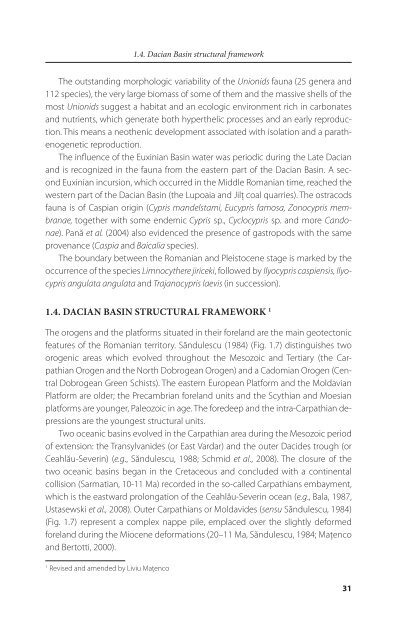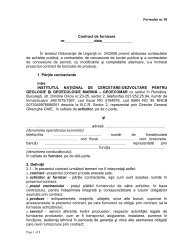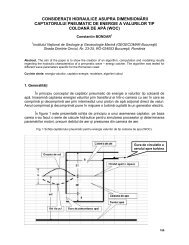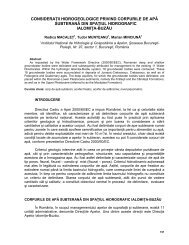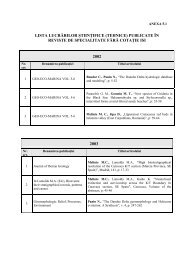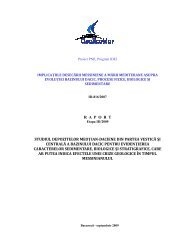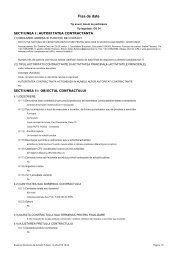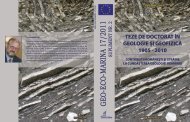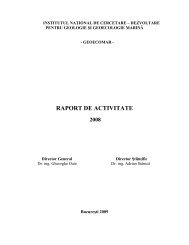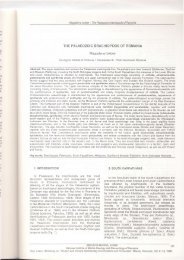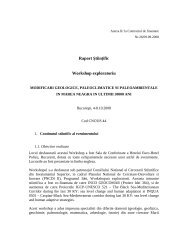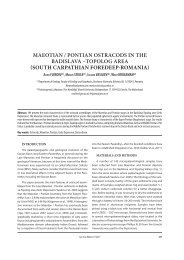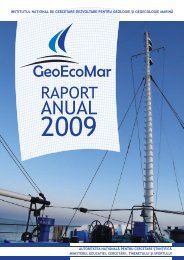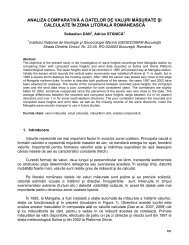DACIAN BASIN - GeoEcoMar
DACIAN BASIN - GeoEcoMar
DACIAN BASIN - GeoEcoMar
You also want an ePaper? Increase the reach of your titles
YUMPU automatically turns print PDFs into web optimized ePapers that Google loves.
1.4. Dacian Basin structural framework<br />
The outstanding morphologic variability of the Unionids fauna (25 genera and<br />
112 species), the very large biomass of some of them and the massive shells of the<br />
most Unionids suggest a habitat and an ecologic environment rich in carbonates<br />
and nutrients, which generate both hyperthelic processes and an early reproduction.<br />
This means a neothenic development associated with isolation and a parathenogenetic<br />
reproduction.<br />
The influence of the Euxinian Basin water was periodic during the Late Dacian<br />
and is recognized in the fauna from the eastern part of the Dacian Basin. A second<br />
Euxinian incursion, which occurred in the Middle Romanian time, reached the<br />
western part of the Dacian Basin (the Lupoaia and Jilţ coal quarries). The ostracods<br />
fauna is of Caspian origin (Cypris mandelstami, Eucypris famosa, Zonocypris membranae,<br />
together with some endemic Cypris sp., Cyclocypris sp. and more Candonae).<br />
Pană et al. (2004) also evidenced the presence of gastropods with the same<br />
provenance (Caspia and Baicalia species).<br />
The boundary between the Romanian and Pleistocene stage is marked by the<br />
occurrence of the species Limnocythere jiriceki, followed by Ilyocypris caspiensis, Ilyocypris<br />
angulata angulata and Trajanocypris laevis (in succession).<br />
1.4. <strong>DACIAN</strong> <strong>BASIN</strong> STRUCTURAL FRAMEwORk 1<br />
The orogens and the platforms situated in their foreland are the main geotectonic<br />
features of the Romanian territory. Săndulescu (1984) (Fig. 1.7) distinguishes two<br />
orogenic areas which evolved throughout the Mesozoic and Tertiary (the Carpathian<br />
Orogen and the North Dobrogean Orogen) and a Cadomian Orogen (Central<br />
Dobrogean Green Schists). The eastern European Platform and the Moldavian<br />
Platform are older; the Precambrian foreland units and the Scythian and Moesian<br />
platforms are younger, Paleozoic in age. The foredeep and the intra-Carpathian depressions<br />
are the youngest structural units.<br />
Two oceanic basins evolved in the Carpathian area during the Mesozoic period<br />
of extension: the Transylvanides (or East Vardar) and the outer Dacides trough (or<br />
Ceahlău-Severin) (e.g., Săndulescu, 1988; Schmid et al., 2008). The closure of the<br />
two oceanic basins began in the Cretaceous and concluded with a continental<br />
collision (Sarmatian, 10-11 Ma) recorded in the so-called Carpathians embayment,<br />
which is the eastward prolongation of the Ceahlău-Severin ocean (e.g., Bala, 1987,<br />
Ustasewski et al., 2008). Outer Carpathians or Moldavides (sensu Săndulescu, 1984)<br />
(Fig. 1.7) represent a complex nappe pile, emplaced over the slightly deformed<br />
foreland during the Miocene deformations (20–11 Ma, Săndulescu, 1984; Maţenco<br />
and Bertotti, 2000).<br />
1 Revised and amended by Liviu Maţenco<br />
31


